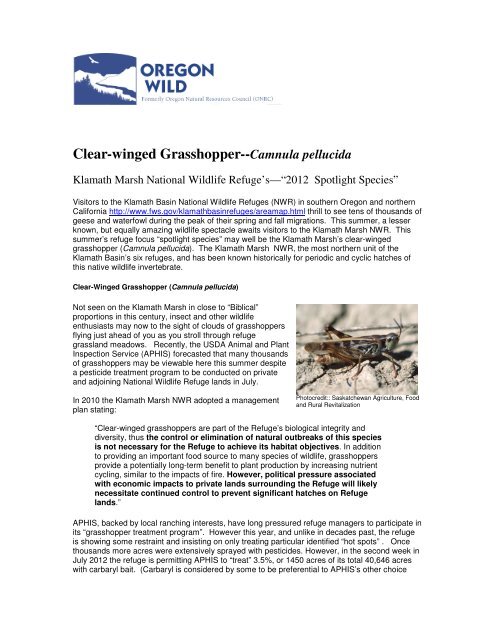Clear-winged Grasshopper--Camnula pellucida - Oregon Wild
Clear-winged Grasshopper--Camnula pellucida - Oregon Wild
Clear-winged Grasshopper--Camnula pellucida - Oregon Wild
You also want an ePaper? Increase the reach of your titles
YUMPU automatically turns print PDFs into web optimized ePapers that Google loves.
<strong>Clear</strong>-<strong>winged</strong> <strong>Grasshopper</strong>--<strong>Camnula</strong> <strong>pellucida</strong><br />
Klamath Marsh National <strong>Wild</strong>life Refuge’s—“2012 Spotlight Species”<br />
Visitors to the Klamath Basin National <strong>Wild</strong>life Refuges (NWR) in southern <strong>Oregon</strong> and northern<br />
California http://www.fws.gov/klamathbasinrefuges/areamap.html thrill to see tens of thousands of<br />
geese and waterfowl during the peak of their spring and fall migrations. This summer, a lesser<br />
known, but equally amazing wildlife spectacle awaits visitors to the Klamath Marsh NWR. This<br />
summer’s refuge focus “spotlight species” may well be the Klamath Marsh’s clear-<strong>winged</strong><br />
grasshopper (<strong>Camnula</strong> <strong>pellucida</strong>). The Klamath Marsh NWR, the most northern unit of the<br />
Klamath Basin’s six refuges, and has been known historically for periodic and cyclic hatches of<br />
this native wildlife invertebrate.<br />
<strong>Clear</strong>-Winged <strong>Grasshopper</strong> (<strong>Camnula</strong> <strong>pellucida</strong>)<br />
Not seen on the Klamath Marsh in close to “Biblical”<br />
proportions in this century, insect and other wildlife<br />
enthusiasts may now to the sight of clouds of grasshoppers<br />
flying just ahead of you as you stroll through refuge<br />
grassland meadows. Recently, the USDA Animal and Plant<br />
Inspection Service (APHIS) forecasted that many thousands<br />
of grasshoppers may be viewable here this summer despite<br />
a pesticide treatment program to be conducted on private<br />
and adjoining National <strong>Wild</strong>life Refuge lands in July.<br />
In 2010 the Klamath Marsh NWR adopted a management<br />
plan stating:<br />
Photocredit:: Saskatchewan Agriculture, Food<br />
and Rural Revitalization<br />
“<strong>Clear</strong>-<strong>winged</strong> grasshoppers are part of the Refuge’s biological integrity and<br />
diversity, thus the control or elimination of natural outbreaks of this species<br />
is not necessary for the Refuge to achieve its habitat objectives. In addition<br />
to providing an important food source to many species of wildlife, grasshoppers<br />
provide a potentially long-term benefit to plant production by increasing nutrient<br />
cycling, similar to the impacts of fire. However, political pressure associated<br />
with economic impacts to private lands surrounding the Refuge will likely<br />
necessitate continued control to prevent significant hatches on Refuge<br />
lands.”<br />
APHIS, backed by local ranching interests, have long pressured refuge managers to participate in<br />
its “grasshopper treatment program”. However this year, and unlike in decades past, the refuge<br />
is showing some restraint and insisting on only treating particular identified “hot spots” . Once<br />
thousands more acres were extensively sprayed with pesticides. However, in the second week in<br />
July 2012 the refuge is permitting APHIS to “treat” 3.5%, or 1450 acres of its total 40,646 acres<br />
with carbaryl bait. (Carbaryl is considered by some to be preferential to APHIS’s other choice
which is a pesticide known as Dimilin. Dimilin is a broad spectrum agent that kills many insect<br />
species (including natural enemies of grasshoppers.)<br />
Contact the refuge, to learn where best to observe refuge and area grasshoppers that<br />
survive as <strong>winged</strong> adults, and to also possibly express tepid support of their decision to<br />
do more minimal pesticide treatments--Klamath Marsh NWR, HC 63 Box 303, Chiloquin, OR<br />
97624 541-783-3380; and/or Klamath Basin National <strong>Wild</strong>life Refuges Route 1, Box 74 Tulelake,<br />
California 96134 530-667-2231<br />
Additional Background on <strong>Clear</strong>-<strong>winged</strong> <strong>Grasshopper</strong>s: Birds and other wildlife species take<br />
advantage of what nature provides that is nourishing and available to them. Besides the vast<br />
array of bird attracted by clear-<strong>winged</strong> grasshoppers, other vertebrates species including mice,<br />
shrews, gophers and badgers all eat grasshoppers and their egg pods. Coyotes, skunks, lizards,<br />
snakes, toads, bobcats and foxes also eat both nymphs and adults. Birds, especially gulls and<br />
meadowlarks, have even been attributed with stopping grasshopper hatches in other parts of the<br />
country. Many birds scratch up the egg cases, and have been credited with clearing from 5 to<br />
150 acres of grasshopper egg pods. This is more likely to happen when a habitat area provides<br />
food and refuge for the birds.<br />
Both cattle and grasshoppers eat grass. However it is the cows that are<br />
the Klamath Marsh’s largest exotic, non-native species.<br />
While, in theory, farm and ranch areas could create habitats more attractive to birds to encourage<br />
predation on grasshoppers—they seldom do. Thus, our National <strong>Wild</strong>life Refuges are ideally the<br />
best dependable places to provide essential habitats for all vertebrate and invertebrate wildlife<br />
species--while also providing a place for the public to experience these remarkable <strong>winged</strong><br />
wildlife displays. There is no refuge purpose served by destroying natural, cyclic grasshopper<br />
populations.<br />
During a prior grasshopper hatch a decade ago, the <strong>Oregon</strong>ian (Aug. 28, 2002) quoted a<br />
former Klamath Marsh NWR manager:<br />
“<strong>Grasshopper</strong>s also eat many weed plants and are an important food source for many<br />
animals. Walter Ford, manager of the Klamath Marsh National <strong>Wild</strong>life Refuge, said<br />
flocks of ravens, hawks, cranes, blackbirds and other marsh birds are happily feasting<br />
on the grasshoppers. ‘We don’t have the same concern that the ranchers do,’ Ford said.
‘We can tolerate higher levels of grasshoppers. But we feel to be good neighbors, we<br />
have to consider treatment options.”<br />
Distinguishing Characteristics. The adults are yellowish to brownish in color and approximately<br />
21-32 mm (0.8 to 1.3 inches) in length. Their wings are clear but mottled with dark patches and<br />
they have two stripes beginning at the thorax and converging at the tip of the forewings.<br />
The newly hatched young, body length 4.2 to 5.5 mm, are remarkably colored black with a<br />
distinctive white band encircling the thorax.<br />
<strong>Camnula</strong> <strong>pellucida</strong> nymph and egg pod with loose eggs. University of Wyoming<br />
Habitat -- The clear-<strong>winged</strong> grasshopper prefers to lay its eggs in sod on road allowances,<br />
overgrazed pastures and dried out marshy areas. Congregation of the adults during egg laying may<br />
result in as many as 10,000 or more eggs per square meter. (Saskatchewan Agriculture, Food &<br />
Rural Revitalization)<br />
Food Supply . The clear-<strong>winged</strong> grasshopper is primarily a grass feeder that prefers cereal<br />
grains and some of the more succulent cultivated grasses. It seldom feeds on broad-leaved<br />
plants. Large pastures of native grasses are usually only infested around their margins where<br />
cultivated fields are close by. (Saskatchewan Agriculture, Food & Rural Revitalization)<br />
Best viewing times: The clear-<strong>winged</strong> grasshopper, a diurnal insect, is active during the day<br />
and inactive at night--in sheltered places protected from the cold. As the morning sun warms the<br />
habitat, the grasshoppers slowly crawl from their hiding places and seek sunny positions<br />
aggregating on bare soil, earth clods, and dried cattle dung. (University of Wyoming)<br />
In previous years clear-<strong>winged</strong> grasshoppers have been readily viewable at the Klamath<br />
Marsh NWR boundary along the Silver Lake Hwy. approximately 5 miles east of Hwy. 97.<br />
Masses of <strong>winged</strong> adults can also sometimes be viewed on the east side of the refuge at<br />
Abraham Flat, or in fields where the Military Road (to the north) crosses the refuge’s<br />
middle, western boundary.<br />
For more information see ODA grasshopper webpage,<br />
http://www.oregon.gov/ODA/PLANT/IPPM/gh_ea12.shtml.



